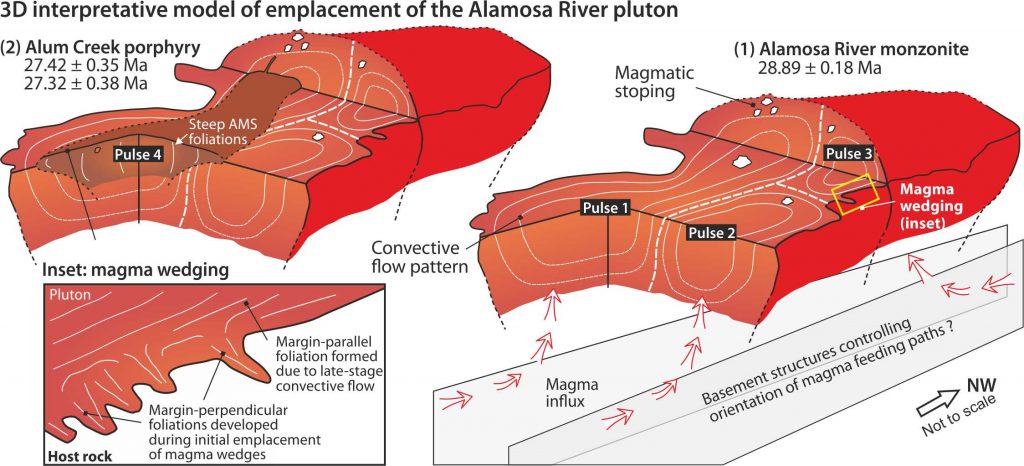 Volcanic calderas are hazardous phenomena associated with cataclysmic eruptions that threaten surrounding nature, human society, and may also affect climate on a global scale. Active calderas are thus carefully monitored, however the underlying magma plumbing systems that store eruptible melt and feed ignimbrite eruptions are still poorly understood. In this paper, we have focused on the extinct Platoro caldera complex that erupted six large ignimbrite sheets between 30.2 Ma and 28.8 Ma in the Rocky Mountains (Colorado), and is associated with voluminous postcaldera intrusions. Using a multiparametric study (field mapping, petrography, radiometric dating, rock magnetism and anisotropy of magnetic susceptibility) of the Alamosa River pluton (29.0–27.3 Ma), we discovered an interesting behavior of magmatic activity that occurred after the main collapse episode. It has been documented that shallow-level magmatic systems of collapsed calderas remain active for another few millions of year, and produce multipulsed intrusions and complex dike swarms. Moreover, such intrusion are further distinguished as resurgent and postresurgent. The former induces ground deformation in form of uplifted domes, whereas the latter has no effect at the Earth´s surface.
Volcanic calderas are hazardous phenomena associated with cataclysmic eruptions that threaten surrounding nature, human society, and may also affect climate on a global scale. Active calderas are thus carefully monitored, however the underlying magma plumbing systems that store eruptible melt and feed ignimbrite eruptions are still poorly understood. In this paper, we have focused on the extinct Platoro caldera complex that erupted six large ignimbrite sheets between 30.2 Ma and 28.8 Ma in the Rocky Mountains (Colorado), and is associated with voluminous postcaldera intrusions. Using a multiparametric study (field mapping, petrography, radiometric dating, rock magnetism and anisotropy of magnetic susceptibility) of the Alamosa River pluton (29.0–27.3 Ma), we discovered an interesting behavior of magmatic activity that occurred after the main collapse episode. It has been documented that shallow-level magmatic systems of collapsed calderas remain active for another few millions of year, and produce multipulsed intrusions and complex dike swarms. Moreover, such intrusion are further distinguished as resurgent and postresurgent. The former induces ground deformation in form of uplifted domes, whereas the latter has no effect at the Earth´s surface.
Tomek F., Gilmer A.K., Petronis M.S., Lipman P.W., Foucher M.S. (2019): Protracted multipulse emplacement of a post‐resurgent pluton: the case of Platoro caldera complex (Southern Rocky Mountain volcanic field, Colorado). Geochemistry, Geophysics, Geosystems 20, 5225-5250. (DOI)








